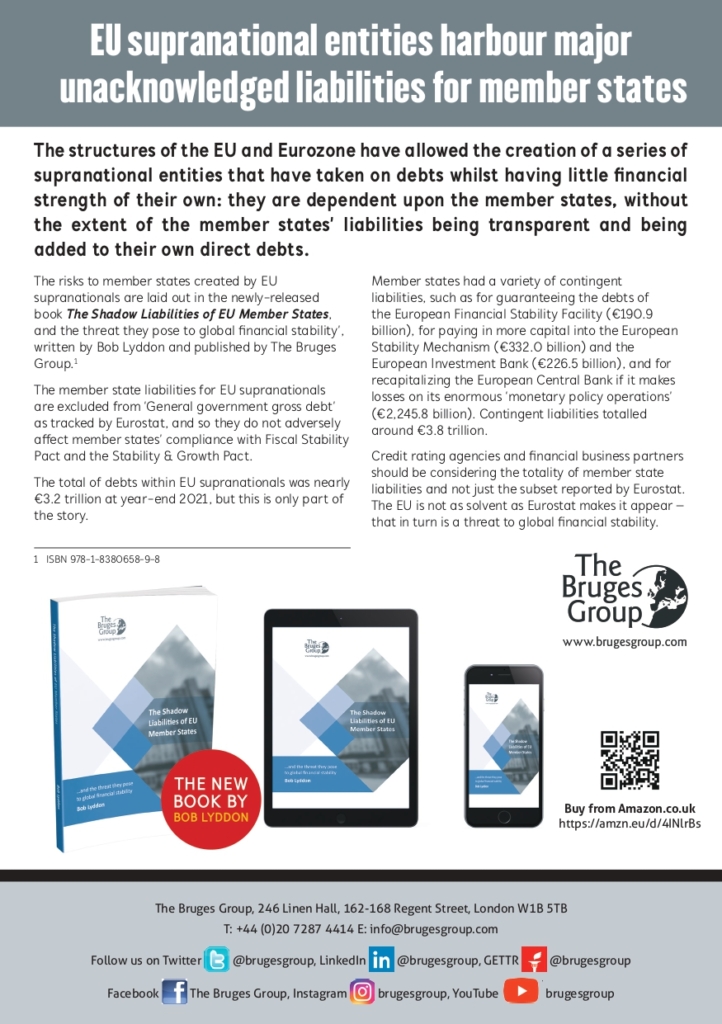Published on 21st April 2023
The structures of the EU and Eurozone have allowed the creation of a series of supranational entities that have taken on debts whilst having little financial strength of their own: their creditworthiness depends on guarantees or capital calls from member states, without the extent of the member states’ liabilities being transparent and being added to their own direct debts.
The risks to member states created by EU supranationals are laid out in the newly-released book ‘The shadow liabilities of EU Member States, and the threat they pose to global financial stability’, written by Bob Lyddon and published by The Bruges Group.[1]
The European Union entity had, at the end of 2021, €174.8 billion of debts for which the member states were responsible, of which less than half was attributable to the €750 billion Coronavirus Recovery Fund. In due course the Fund will become drawn and the whole drawn amount will be an EU debt that the member states underwrite. Currently the larger, undrawn portion still sits within the €792.7 billion for which the member states have a contingent liability.
In addition to the EU’s debt, there are the debts within the TARGET2 payment system, which were reported by the ECB as being €1.8 trillion: €1.5 trillion owed by Eurozone national central banks and €0.3 trillion owed by the ECB itself.[2] These figures eliminated an amount of €1.5 trillion based on a questionable netting process. The gross TARGET2 debts of Eurozone national central banks (and therefore of member states) were €3.0 trillion and not the netted figure of €1.5 trillion.
The total of debts within EU supranationals was thus nearly €3.2 trillion.
The contingent liabilities sat on the books of six supranationals as follows:
- European Union – €792.7 billion, mainly the undrawn portion of the Coronavirus Recovery Fund
- The European Financial Stability Facility – €190.9 billion
- The European Stability Mechanism – €332.0 billion
- The European Investment Bank – €226.5 billion
- The European Guarantee Facility – €23.2 billion
- The European Central Bank: exposure to recapitalizing the ECB in case it makes Market losses on its operations – €826.0 billion
- The European Central Bank: exposure to recapitalizing the ECB in case it makes Credit losses on its operations – €1,419.8 billion or €1.4 trillion
- Total of contingent liabilities – €3,811.1 billion or €3.8 trillion
Member states are trying to control their ‘General government gross debt’ figure as it is the numerator in the ratio of Debt-to-Gross Domestic Product used to measure their compliance with the Fiscal Stability Pact and the Stability & Growth Pact. It is hugely helpful to have access to the EU supranationals who can indebt themselves on behalf of the member states and spend the money in member states, without the debt being tracked into the member states’ ‘General government gross debt’.
Credit rating agencies and financial business partners should not be so easily gulled by this accounting legerdemain, and nor should other governments and global bodies responsible for systemic stability: the extent of the hidden liabilities of EU member states is a threat to the global economic order.
[1] ISBN 978-1-8380658-9-8
[2] This €335 billion can be considered as sitting within the member states’ risk for recapitalizing the ECB

